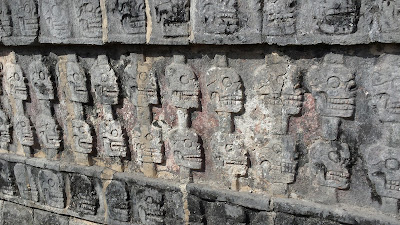This sacred site has long
been on my life list of places to visit. I use the word
"awesome" far too often, but Chichen Itza is awesome in the
truest sense of the word: awe-inspiring. The site was first settled by
the Mayans sometime in the 5th century A.D. The bloody Toltecs swept across the
Yucatan in the 9th century and muscled in on the Mayans. Built in the 10th century, Chichen Itza is a magnificent representation of the hybrid Mayan-Toltec culture. It retains a vivid, visceral sense of a functioning city, with temples, buildings, streets, a marketplace that was once covered in a thatched palapa. There's even a huge ball court, as
long as a football field but a little less wide. This city was the site of the Mayan Superbowl. It was breathtaking. I'm
glad I lived long enough to see it.
The great Kukulkan, El Castillo:
Temples, castles, government buildings.
The market place
The carvings; oh, the carvings. Mind blowing, strange, beautiful, scary. The Toltecs had a thing about death, that's for sure. The skulls imagery is like nothing I've ever seen. Were the Toltecs Deadheads? I was mesmerized by the carvings of the feathered serpent god Kukulkan, the dragon-like crocodiles; snake scales, geometric and tic-tac-toe images. It's all too beautiful.
There was a algae-infested, pea-green cenote at Chichen Itza, the only cenote we saw that wasn't clear blue. This one was wide open to the elements, so that might have had something to do with it. It was long rumored to have been the site of human sacrifice. National Geographic sent a crew of divers into the cenote in 2011 and they found the remains of six humans, including three children. Those Toltecs did not mess around.
It made Sequoia happy enough to dance. You know how the boy loves his basketball.


































No comments:
Post a Comment